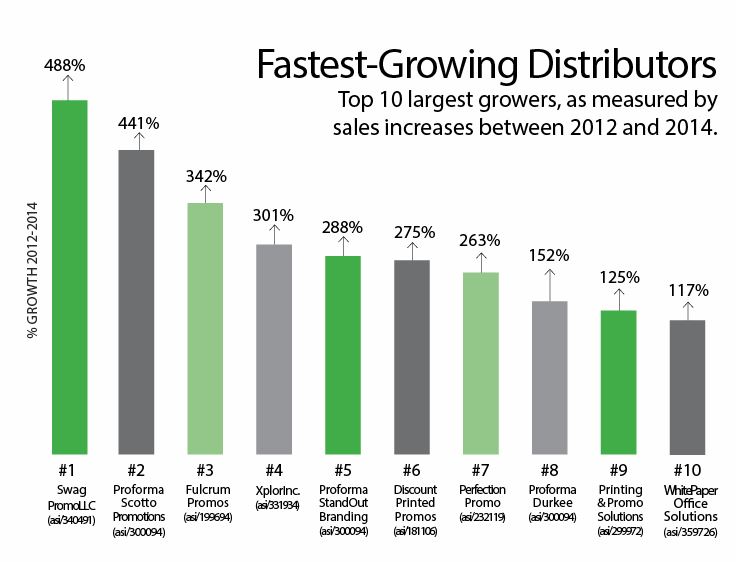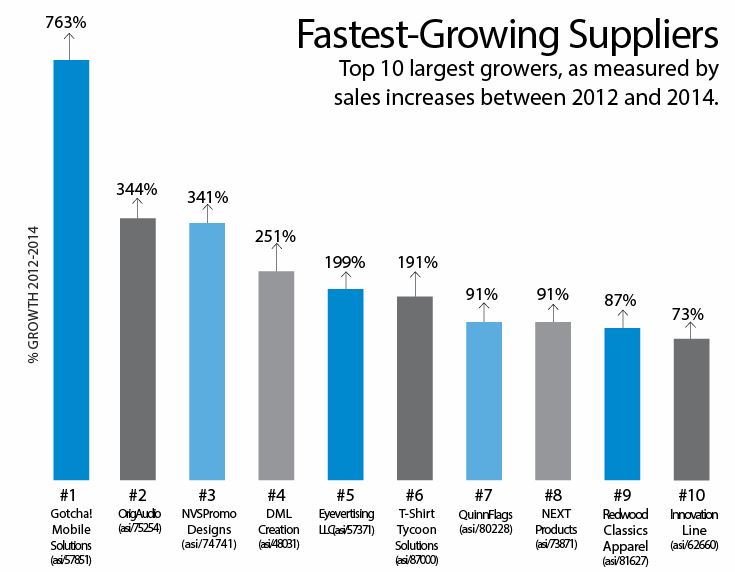Awards June 10, 2015
The Fastest-Growing Promo Product Companies
Meet the firms – both distributors and suppliers – that have achieved the most revenue growth over the past three years.
Fast growth and hyper success can come from many different strategies. It can be derived through aggressive sales tactics or creative marketing strategies or unique approaches to digital commerce. This year’s list of the industry’s fastest-growing companies – measured by revenues from 2012-2014 – showcases distributors and suppliers that don’t settle for anything ordinary.
The special group is a collection of companies run by entrepreneurs willing to take risks to be able to capitalize on the opportunities that today’s market presents. Ultimately, though, what works for these companies is, well, really working. These firms measure success by triple-digit growth, not the double-digit marker that many others aspire to.
Here’s a look at the fastest-growing ad specialty firms, with profiles of the top distributor and supplier on this year’s list.
Swag Promo
A virtual workplace leads this distributor firm to a nearly 500% revenue increase over the past few years.
There are a lot of reasons Jim Owen’s company is successful. But none more than this: “It’s a virtual, decentralized company,” says Owen, president of Swag Promo LLC (asi/340491), based in Atlanta.
The fact that sales have jumped at Owen’s company from $400,000 in 2012, when Swag was launched, to $2.3 million last year (two-year growth rate of 488%), is as impressive as the colossal savings the distributorship enjoys year over year with almost no overhead. A showroom and small sales office are all Owen and his team of seven pay for, thanks to a management mandate that everyone work from home. The money saved by doing so runs north of $250,000 a year, Owen estimates. The market strategy “is a mint,” he says, and far outweighs any drawbacks of going virtual. “It’s allowed us to grow sales really quickly.”
And that might just be Swag’s brilliance. While telecommuting may not be new, recent research shows that it is on the rise. A Forester Research report found that virtual workers are expected to increase to 63 million people by 2016, up from 34 million in 2009. Studies show that a virtual workplace often results in fewer sick days, reduced travel costs, higher productivity and increased employee retention. For Swag, Owen says, it just seemed like a more logical, financially sound choice.
Owen, who spent many years in the industry before strategizing Swag’s operational approach in 2013, says he was always confounded by the money and manpower distributors wasted by operating massive warehouses with expansive staffs. After doing that for a dozen years, “you look at it and say, ‘Are we really making money on all this fulfillment?’” Owen asks. “We pay for facilities but don’t use them all the time for all clients.”
Owen was convinced he could have the capability to service large corporate clients “without having to own all those capabilities.” How? “I just outsource it,” Owen adds. “I cut out the overhead.”
In its place, Swag relies on vendor partners and ambitious, self-motivated, home-based employees. And Owen says he uses the company’s philosophy of a virtual workforce to test new hires. For example, he walks each new recruit through the company’s showroom. And while Owen doesn’t believe in paying for expensive warehouses that aren’t running full tilt year round, he does endorse the idea of a well-branded showroom to build client rapport and education. So, if an applicant “comes in and says, ‘Boy, you’ve got a really nice showroom. Why did you spend this much money on a showroom?’ then I get the feeling that the person really isn’t going to go out and become a brand ambassador for our company,” Owen says.
But his more economical approach to business is not without its challenges, Owen admits. One of the biggest is communication and staff cohesiveness – elements that naturally materialize when workers share the same office space. “It’s something we work hard to overcome,” Owen says.
It helps that five of the company’s seven employees are at least within the same city. To build greater camaraderie and communication, those staff members meet for lunch frequently and attend vendor meetings in the company’s showroom. And Owen insists that pushing staff to pick up the phone to communicate instead of using email goes a long way in building rapport. “It’s 2015, and we can text our way into oblivion,” Owen says. “But we also have telephones. Let’s pick up the phone and talk to one another.”
The same holds true for customers, who Swag tries to connect with in a way that their competitors don’t. It helps that Owen launched the company in an economy that was on the mend, in a city with a strong promotional products marketplace. More to the point, from the start, Swag’s sales team focused on targeting ad specialty-heavy industries and clients, mostly large corporate buyers and national nonprofits. But Owen attributes much of their success to the company’s branding efforts as well. The company’s name, for example, was purposefully chosen to reflect the language used by some of the industry’s top clients, Owen says.
“We created branding that was a little on the edge,” he says, and aimed it at their typical buyer – a 30 to 35-year-old female who often uses the word “swag” to describe the industry’s offerings. The primary buyers of mid-size to large corporations and nonprofits, in fact, “tend to be mid-level marketing managers, and the demographic of that employee trends toward the 30 to 35-year-old female,” Owen says.
In today’s ad specialty marketplace, “we can’t differentiate in product,” Owen says. “You just cannot do that,” since every distributor sells the same product, he adds. Similarly, “I can’t differentiate too much in price.” So the company had to set itself apart in other ways. “I think our branding has been a big part of that,” Owen says, starting with its name and logo.
Along with that branding appeal comes more business. To accommodate that, Owen has nixed the bulky warehouse and facilities functions he so despises for a leaner model that leverages strategic partners to complete order fulfillment. That way, Owen says, Swag can kick into action for large orders quickly, without having to pay for idle storage space when those orders aren’t coming in.
Gotcha! Mobile Solutions
New product category and approach lead this supplier to quick growth.
Several years ago, Christopher Jenkin was standing on a chair yelling about mobile marketing to anyone who would listen. Jenkin, CEO of Dallas-based Gotcha! Mobile Solutions (asi/57851), recalls slowly gaining the attention of his audience and those of nearby groups who were part of a small tech symposium.
“I was telling people that if your website wasn’t mobile-friendly then you were doomed, because smartphones were going to take over the world, since everybody was searching off of mobile devices, blah, blah, blah,” Jenkin says.
Not everybody was listening, though, including his former employer. Frustrated with his company’s outlook, Jenkin took his message elsewhere and started out on his own. He launched a business that’s seeing explosive growth based upon the premise that companies need to improve their mobile and digital offerings.
Last year Gotcha! pulled in more than $2 million in sales, up from $246,000 in 2012, a little over a year after it was formed. And Jenkin just might be onto something. Marketers are predicted to spend $31 billion on mobile advertising by 2017, up from $8 billion in 2013, according to Chief Marketing Officer Council Worldwide. Jenkin is banking on that trend fueling a need by distributors and their clients to boost their mobile promotional marketing efforts.
Though Gotcha! doesn’t sell traditional tangible promotional products, Jenkin says the supplier is helping distributors offer greater promotional opportunities to their clients. “Our job is to help companies make more money online. Period,” Jenkin says. “And our distributors take the solutions that we offer and bring them to their customers.”
With services such as Web design, search optimization, QR code management and app development, Gotcha! offers technology – billed as a powerful promotional tool – that distributors can sell to their clients. Relying on partnerships with large distributor groups (Top 40 distributor Proforma is a top client), Gotcha! funnels its mobile marketing services to distributor clients, targeting distributors with sales upwards of $250,000 a year who have a solid foothold in the industry.
No doubt, it’s a unique promotional offering, but Jenkin believes that the industry needs shaking up, and he thinks he’s got the product offering to do it. With that, Jenkin has lofty goals – to grow the company to more than $40 million. Its growth rate so far has it on the right track.
Fastest-Growing Distributors
Top 10 largest growers, as measured by sales increases between 2012 and 2014.

Fastest-Growing Suppliers
Top 10 largest growers, as measured by sales increases between 2012 and 2014.

